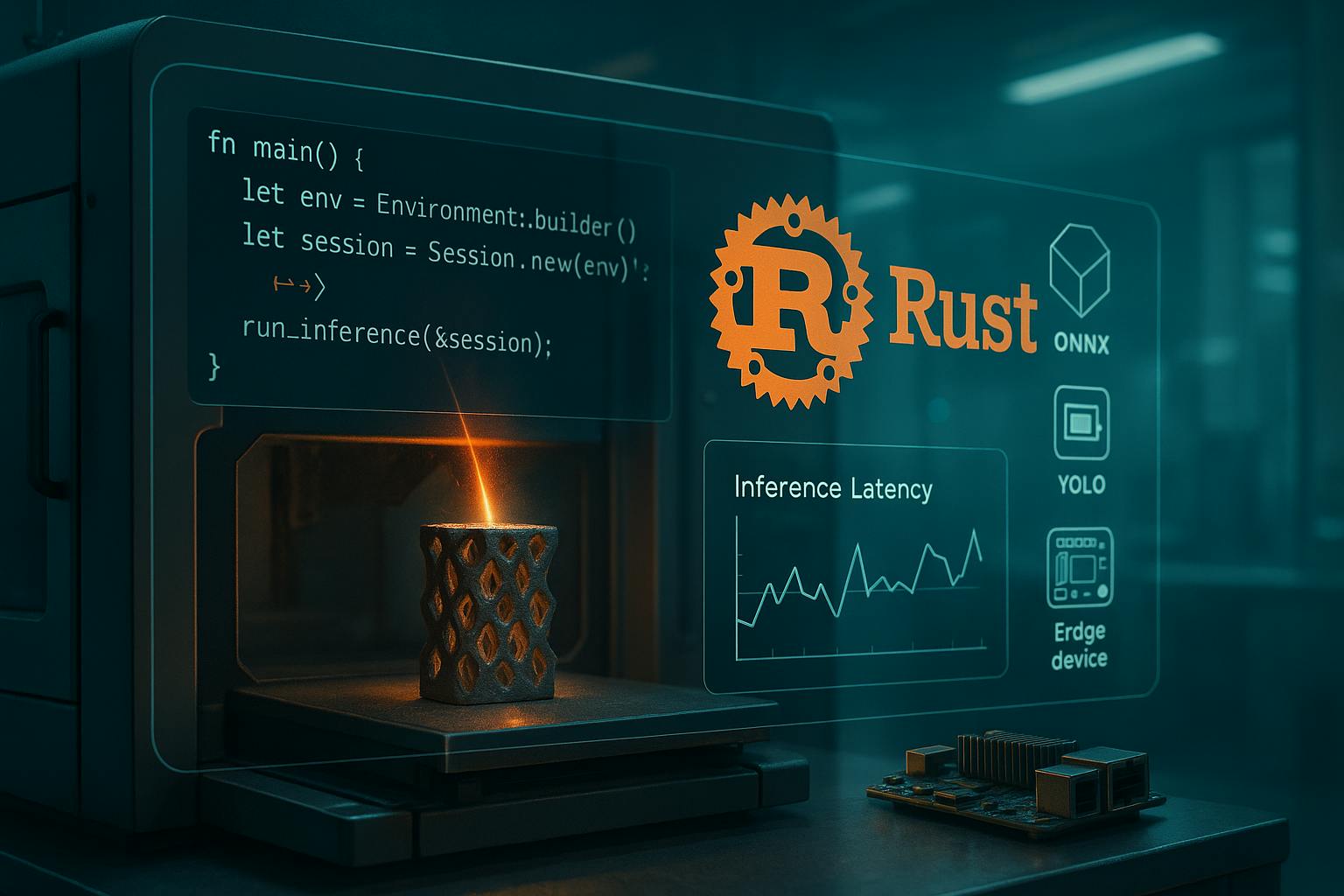In modern manufacturing, especially additive manufacturing (3D printing), defect detection is a non-negotiable requirement. A small flaw during production can lead to expensive downtime, wasted materials, or catastrophic failures in critical parts.
Traditionally, AI solutions for defect detection rely on deep learning models trained in Python (e.g., TensorFlow, PyTorch). These models achieve high accuracy in the lab, but deployment on edge devices, the IoT cameras and embedded boards sitting right on the factory floor, introduces problems:
- Latency: Can the system detect a defect in real time?
- Safety: Will the system run reliably without crashing production pipelines?
- Efficiency: Can it run on resource-constrained devices without cloud dependency?
That’s where Rust enters the picture.
n Why Rust?
Rust ensures memory safety without a garbage collector:
Rust’s system ensures that ownership is managed safely, eliminating the need for a garbage collector, making a more predictable and stable system. This is foundational when deploying critical systems on the edge; no crashes due to buffer overflows, dangling pointers, or GC-induced pauses. Rust enables shipping software faster and offers memory safety in embedded systems.
High Performance: Close to C/C++ speeds, ensuring inference happens within tight real-time constraints.
Cross-Platform Deployment: From ARM-based IoT boards (Raspberry Pi, Jetson Nano) to x86 industrial PCs.
Modern Ecosystem for AI: Libraries like onnxruntime-rs allow loading pretrained models (YOLO, U-Net, ResNet) directly into Rust applications.
For manufacturers adopting industrial AI standards, this combination means trustworthy AI on the shop floor.
Real-World Pipeline: Defect Detection at the Edge
Here’s a real-world example pipeline inspired by my research in deep learning-based segmentation for defect detection in metal additive manufacturing (GitHub Repo):
-
Train the Model in Python:
Use YOLOv8 or U-Net to train on metal defect datasets (segmentation masks, classification labels).
Evaluate performance on test sets to ensure accuracy.
-
Export to ONNX:
Convert the trained model to the ONNX format, a cross-framework standard for model deployment.
Example:
model.export(format=”onnx”)
-
Deploy with Rust + ONNX Runtime:
Load the model using onnxruntime-rs.
Capture video frames from a camera feed in real time.
Run inference in Rust, checking each frame for anomalies.
-
Trigger Alerts:
If a defect is detected, the system immediately raises an alert (e.g., stopping the printer, sending a signal to operators).
n
n Rust Code Sketch
use onnxruntime::{environment::Environment, session::SessionBuilder};
use opencv::videoio;
fn main() -> anyhow::Result<()> {
// Initialize ONNX runtime
let env = Environment::builder().build()?;
let session = SessionBuilder::new(&env)?
.with_model_from_file("yolo_model.onnx")?;
// Capture video frames
let mut cam = videoio::VideoCapture::new(0, videoio::CAP_ANY)?;
loop {
let mut frame = opencv::core::Mat::default();
cam.read(&mut frame)?;
// Preprocess frame → feed into model
// Run inference → check for defects
// If defect → send alert
}
Ok(())
}
This minimal sketch shows how Rust can glue together ONNX inference and real-time video processing. This code still needs robust error handling, camera validation, proper YOLO post-processing, async processing for better performance, and general performance optimization. A full-code example that implements most of these can be seen here.
Why It Matters in Additive Manufacturing
In my research, “Deep Learning-Based Segmentation for Defect Detection in Metal Additive Manufacturing: A custom Neural Network Approach”, the primary focus was on model accuracy and segmentation quality. But scaling this research into real-world manufacturing environments requires more than accuracy, it requires robust, real-time deployment.
Rust could provide the missing pieces in terms of guaranteeing low-latency responses, ensuring inference pipelines run reliably on edge devices, and reducing dependency on only Python environments.
Beyond Manufacturing
The Rust + AI synergy isn’t limited to 3D printing:
- Autonomous robotics: Safe navigation decisions in milliseconds.
- Smart agriculture: On-device crop disease detection.
- Energy systems: Real-time monitoring of turbines and pipelines.
In all cases, Rust ensures AI systems don’t just think fast, they think safely.
The Future of Rust in AI
The Rust ML ecosystem is still young compared to Python, but the trajectory is clear:
- Frameworks like Burn and Linfa are maturing.
- Bindings to ONNX, TensorFlow Lite, and PyTorch expand deployment possibilities.
- Integration with WebAssembly (WASM) enables cross-platform AI inference in browsers and embedded devices.
As AI continues to move from the cloud to the edge, Rust will play a defining role in building trustworthy, efficient, and safe AI systems.
Lastly,
For researchers and engineers working at the intersection of manufacturing and AI, the challenge is not just building accurate models, it’s making them work reliably in the real world. By bridging deep learning research in Python with safe, high-performance deployment in Rust, we could unlock the true potential of AI in Industry 4.0 trhough smarter, safer, ans more sustainable manufacturing.








